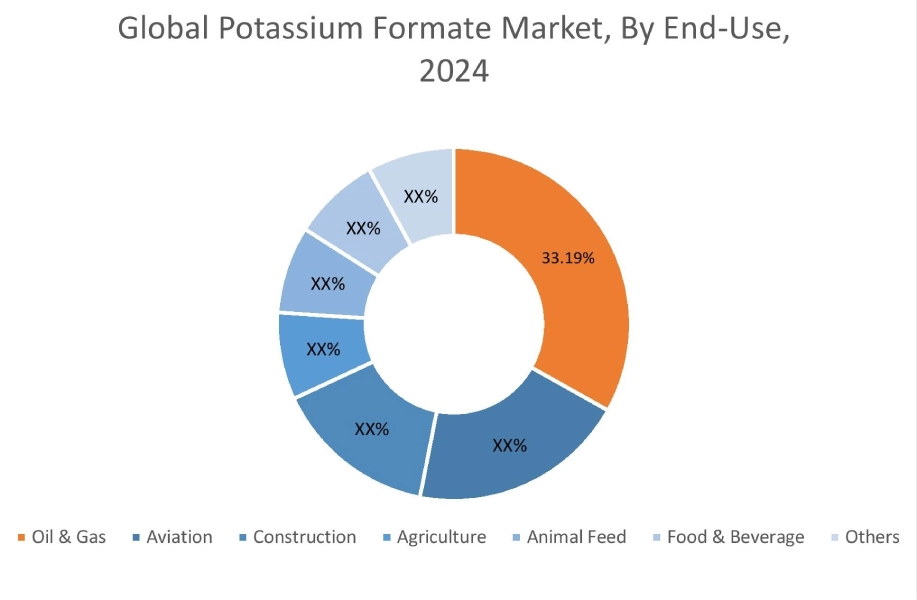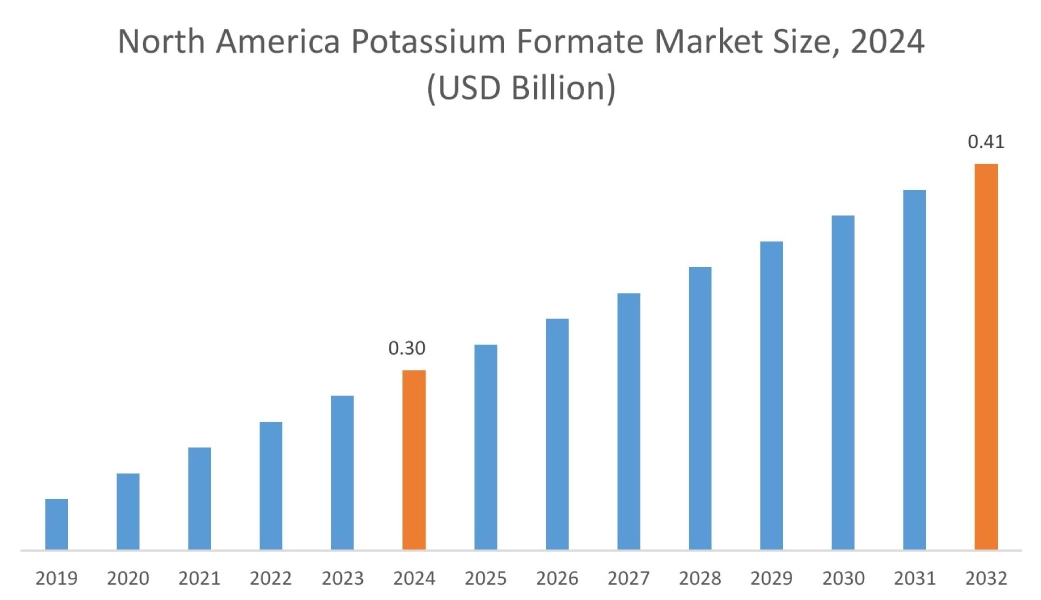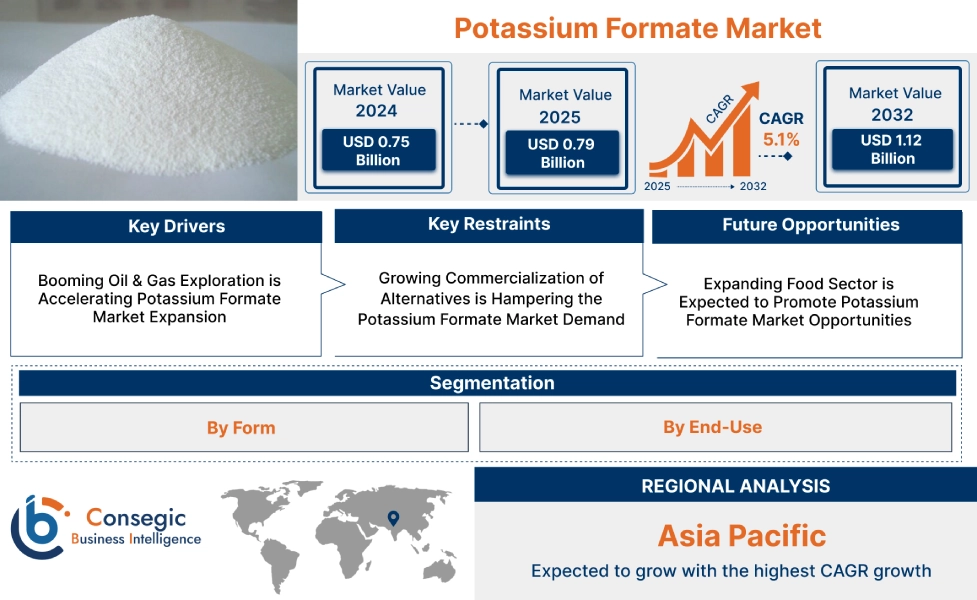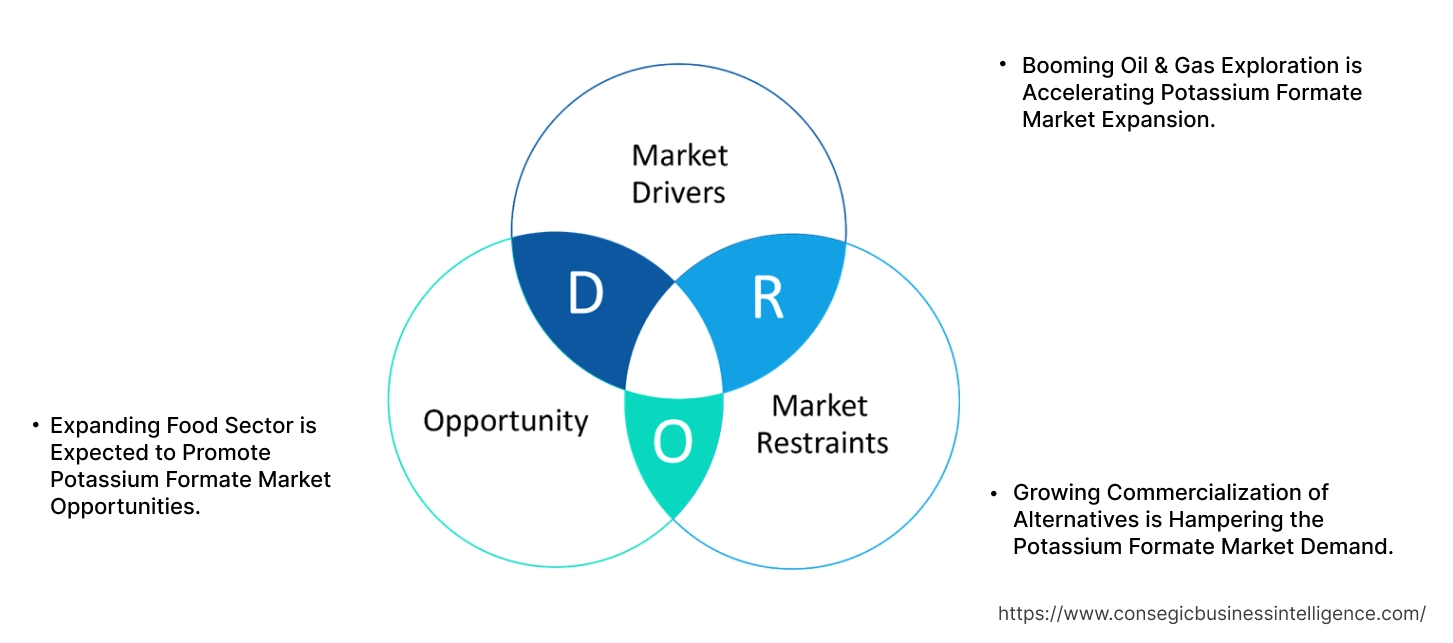Potassium Formate Market Size:
Potassium Formate Market size is growing with a CAGR of 5.1% during the forecast period (2025-2032), and the market is projected to be valued at USD 1.12 Billion by 2032 from USD 0.75 Billion in 2024. Additionally, the market value for the 2025 attributes to USD 0.79 Billion.
Potassium Formate Market Scope & Overview:
Potassium formate is the potassium salt of formic acid. It has the chemical formula HCOOK or HCO₂K. It is a white, crystalline, and strongly hygroscopic solid, meaning it readily absorbs moisture from the air. It is also supplied as a high-density aqueous solution (brine). Industrially, it is primarily produced through the reaction of carbon monoxide (CO) with potassium hydroxide (KOH). Another method involves the reaction of formaldehyde (HCHO) with potassium hydroxide. Key properties include its high solubility in water, excellent thermal stability, low freezing point, and non-corrosive nature compared to chloride salts. It is also biodegradable. These qualities make it ideal for oil and gas drilling fluids, de-icing airport runways and roads, and as a highly efficient and safe heat transfer fluid.
How is AI Impacting the Potassium Formate Market?
AI is impacting the potassium formate market by optimizing production and enhancing supply chain efficiency. By leveraging AI, manufacturers can use predictive analytics to fine-tune reaction parameters like temperature and pH, which increases the yield and purity of the final product while reducing waste and energy consumption. This helps to lower production costs, a key challenge for this market. Furthermore, AI-powered systems can analyze real-time data to forecast demand and manage inventory more accurately, ensuring a stable supply of potassium formate for key industries like oil and gas, de-icing, and agriculture. This technological integration not only streamline operations but also makes the product more competitive and accessible.
Potassium Formate Market Dynamics - (DRO) :
Key Drivers:
Booming Oil & Gas Exploration is Accelerating Potassium Formate Market Expansion.
In the oil & gas sector, potassium formate chemicals are primarily used as a high-performance component in drilling, completion, and workover fluids. Its high density allows for good control in high-pressure environments without relying on suspended solids. Moreover, its high thermal stability makes it ideal for high-pressure, high-temperature (HPHT) wells. Additionally, its non-corrosive and biodegradable nature minimizes equipment damage and environmental impact. This supports greener drilling practices while reducing formation damage for better reservoir protection. Global energy demand is rising due to industrialization and population increase. This has led to an increase in the sector, hence requiring potassium formate for multiple applications.
For instance,
- According to the Energy Information Administration, U.S. natural gas production increased by approximately 4% in 2023 compared to the previous year, thus positively impacting potassium formate market trends.
Overall, the booming oil & gas exploration is significantly boosting the potassium formate market expansion.
Key Restraints:
Growing Commercialization of Alternatives is Hampering the Potassium Formate Market Demand.
The market faces hurdles from the substitutes available in the market. For instance, Sodium chloride is the most common and cheapest de-icing agent globally. This is due to its abundant availability and low processing cost. It is highly effective at melting ice down to around -6°C and is easy to store and spread. Another strong alternative is calcium chloride, as it is more effective at lower temperatures (down to -25°C) and acts faster due to its exothermic reaction to water. It is also less damaging to vegetation than sodium chloride. Additionally, glycols offer excellent freeze protection and heat transfer capabilities, along with corrosion inhibition when properly formulated. Propylene glycol is less toxic, making it safer for certain applications. It is widely used as an anti-freeze and heat transfer fluid in HVAC systems, industrial cooling loops, and automotive coolants. Hence, the growing commercialization of substitutes is hampering the potassium formate market demand.
Future Opportunities :
Expanding Food Sector is Expected to Promote Potassium Formate Market Opportunities.
In the food sector, potassium formate chemical compound is primarily used as a food additive. It is recognized under the E-number E262, which also covers sodium acetates. Its main roles are as a preservative and an acidity regulator. Moreover, it helps inhibit the growth of unwanted microorganisms such as bacteria and fungi, thereby extending the shelf life of certain food products such as sauces, dressings, and some snack foods. Additionally, its low toxicity and biodegradable nature also make it a favorable choice in applications where safety and environmental impact are crucial considerations. The growing global population and changing consumer preferences have led to sector growth, hence positively influencing potassium formate market trends.
For instance,
- According to IBEF, the Indian food industry is expected to grow at a CAGR of 7.2% from 2023 to 2027, creating the potential for the market.
Overall, the expanding food sector is expected to increase the potassium formate market opportunities.
Potassium Formate Market Segmental Analysis :
By Form:
Based on form, the market is categorized into liquid, powder, flakes, and others.
Trends in Form:
- There is a growing trend of using liquid form in industries such as aviation and oil & gas due to its ease of use, de-icing properties, and convenient handling.
- Manufacturers focusing on developing improved solid forms with enhanced properties such as reduced hygroscopicity and better flowability are also a rising trend.
The liquid segment accounted for the largest market share in 2024
- Liquid forms in dominating as they are simpler to pump, mix, and precisely dose in industrial processes. This leads to greater operational efficiency.
- Being already in solution, it dissolves and disperses instantly. This ensures immediate effectiveness in applications such as drilling fluid formulation.
- Moreover, the liquid form offers high density while remaining solids-free, which is crucial for good control in oil & gas without using particulate weighting agents.
- Additionally, it eliminates dust generation associated with powders. This improves worker safety and cleanliness in the handling environment.
- Furthermore, liquid formulations maintain excellent thermal stability, which is crucial for high-temperature applications. These benefits are driving their increased usage.
- Overall, as per the market analysis, the aforementioned factors are driving a segment in the market.
The powder segment is expected to grow at the fastest CAGR over the forecast period.
- Powder form is generally more stable than liquid, with less risk of spoilage and a longer shelf life. This is important for long-term storage or less frequent use.
- Its concentrated nature (less water weight) makes it more efficient to store and transport, reducing logistical costs, particularly for remote or large-scale operations.
- It’s ideal for dry blending and creating specific custom formulations where controlled dosing and precise concentration are required. This form is used as a preservative in animal feed and as deicing salts.
- Climate change has led to more frequent and severe winter storms, increasing the need for effective deicing solutions, hence driving segmental share.
- For instance, according to Outco, over 2 million tonnes of deicing salts are being spread on roads annually in the UK.
- Overall, as per the market analysis, the aforementioned factors will drive a segment in the potassium formate market growth.
By End-Use:
Based on end-use, the market is categorized into oil & gas, aviation, construction, agriculture, animal feed, food & beverage, and others.
Trends in the End-Use
- There is a growing trend of using potassium formate in de-ice runways. This is driven by regulations aiming to minimize corrosion damage to aircraft and airport infrastructure.
- The trend towards sustainable farming and optimizing crop yields is increasing the use of potassium formate as a fertilizer additive.
The oil & gas segment accounted for the largest market share of 33.19% in 2024.
- Potassium formate chemical compound liquid form provides a high density, allowing for effective drilling in deep and complex wells.
- Its stability in high-pressure, high-temperature environments makes it suitable for challenging drilling operations.
- Moreover, it helps prevent shale swelling and formation damage. This improves drilling efficiency and wellbore stability.
- Compared to traditional chloride-based fluids, potassium formate minimizes damage to the reservoir, enhancing well productivity.
- Additionally, it is biodegradable and less harmful to the environment compared to other drilling fluid options. This aligns with stricter environmental regulations. These benefits in the sector are driving its increased usage.
- Overall, as per the market analysis, the aforementioned factors are driving the segment in the potassium formate industry.
The food & beverage segment is expected to grow at the fastest CAGR over the forecast period.
- Potassium formate is used in the food and beverage industry as a preservative and pH regulator.
- It also helps to inhibit the growth of microorganisms, extending the life of food products.
- It is used to enhance the quality and safety of frozen foods and ready-to-eat meals.Busy lifestyles have increased the need for convenient food, hence requiring potassium compounds for multiple applications.
- For instance, according to Tridge, the UK canned food market grew by 7.91% in 2023, compared to the previous year.
- Thus, according to market analysis, the aforementioned factors will drive the segment in the potassium formate market growth.

Regional Analysis:
The regional segment includes North America, Europe, Asia Pacific, the Middle East and Africa, and Latin America.

In 2024, North America accounted for the highest potassium formate market share at 39.78% and was valued at USD 0.30 Billion and is expected to reach USD 0.41 Billion in 2032. In North America, the U.S. accounted for the potassium formate market share of 73.12% during the base year of 2024. There is an evolving oil and gas sector in the region. This is driven by increasing energy demand, technological advancements in extraction, and rising LNG exports.
For instance,
- According to the Energy Information Administration, in the first half of 2023, drillers significantly ramped up their activity, spudding 12% more new wells than in the same period of 2022

The region's extensive shale gas and tight oil drilling activities, particularly in formations such as the Permian Basin, necessitate high-performance drilling and completion fluids. Potassium formate is increasingly favored for its high density, thermal stability, and low corrosiveness, which are critical for navigating complex geological formations and high-pressure, high-temperature (HPHT) wells. Overall, booming oil and gas sectors are driving the market in the region.
In Asia Pacific, the potassium formate market is experiencing the fastest growth with a CAGR of 6.8% over the forecast period. There is rapid expansion of data centers and industrial cooling systems in the APAC. As digital transformation accelerates, the demand for powerful and energy-efficient data centers skyrockets. These facilities require highly effective heat transfer fluids to manage the immense heat generated by servers. Potassium formate's superior thermal conductivity, low freezing point, and non-corrosive nature make it an ideal choice for closed-loop cooling systems. Its environmentally friendly profile also aligns with the growing sustainability goals of companies and governments across APAC. Countries such as China, Japan, India, and South Korea lead the market.
Europe potassium formate market analysis indicates that several key trends are contributing to its growth in the region. There is a robust increase in the aviation sector. The continent experiences severe winter conditions, necessitating efficient and safe de-icing agents for airport runways and aircraft. European airports, driven by stringent environmental regulations (e.g., EU REACH) and a strong focus on minimizing infrastructure corrosion, are increasingly adopting potassium formate-based de-icers. Unlike traditional chloride-based salts, potassium formate is non-corrosive to aircraft materials and runway concrete, ensuring operational safety and extending asset lifespan while reducing environmental impact. Countries such as Germany, France, the UK, and Italy lead the market.
Middle East and Africa (MEA) potassium formate market analysis indicates that there is a growing animal feed sector in the region. As the population grows and living standards improve, there's a rising demand for meat and dairy products, leading to increased livestock production. Potassium formate is increasingly adopted as a crucial feed additive due to its dual benefits. It acts as a highly effective preservative, extending the shelf life of feed by inhibiting microbial spoilage, and it functions as a growth promoter, enhancing nutrient utilization and improving animal performance. Countries such as UAE and Saudi Arabia lead the market.
Latin America's region creates potential for the market. There is a growing focus on expanding geothermal energy and broader renewable energy sectors. Countries such as Chile, Brazil, and Argentina nations possess significant geothermal potential. As these projects develop, there's an increasing need for efficient and environmentally safe heat transfer fluids in geothermal power plants. Potassium formate's low freezing point, high thermal stability, and non-corrosive properties make it an excellent candidate for these closed-loop systems, offering a more sustainable and reliable solution compared to traditional brines, thereby supporting the region's clean energy transition.
Top Key Players and Market Share Insights:
The Potassium Formate market is highly competitive with major players providing products to the national and international markets. Key players are adopting several strategies in research and development (R&D) and product innovation to hold a strong position in the global Potassium Formate market. Key players in The Potassium Formate industry include-
- Hawkins, Inc. (United States)
- Jiangsu Kolod Food Ingredients Co., Ltd. (China)
- Krishna Chemicals (India)
- Perstorp Holding AB (Sweden)
- Clariant AG (Switzerland)
- Dynalene, Inc. (United States)
- American Elements (United States)
- Glentham Life Sciences (United Kingdom)
- Merck KGaA (Germany)
- Thermo Fisher Scientific (United States)
- Dongying Chemical Group Co., Ltd. (China)
- Suvchem Laboratory Chemicals (India)
Potassium Formate Market Report Insights :
| Report Attributes | Report Details |
| Study Timeline | 2019-2032 |
| Market Size in 2032 | USD 1.12 Billion |
| CAGR (2025-2032) | 5.1% |
| By Form |
|
| By End-Use |
|
| By Region |
|
| Key Players |
|
| North America | U.S. Canada Mexico |
| Europe | U.K. Germany France Spain Italy Russia Benelux Rest of Europe |
| APAC | China South Korea Japan India Australia ASEAN Rest of Asia-Pacific |
| Middle East and Africa | GCC Turkey South Africa Rest of MEA |
| LATAM | Brazil Argentina Chile Rest of LATAM |
| Report Coverage |
|
Key Questions Answered in the Report
How big is the Potassium Formate market? +
In 2024, the Potassium Formate market is USD 0.75 Billion.
Which is the fastest-growing region in the Potassium Formate market? +
Asia Pacific is the fastest-growing region in the Potassium Formate market.
What specific segmentation details are covered in the Potassium Formate market? +
Form and End-Use segmentation details are covered in the Potassium Formate market
Who are the major players in the Potassium Formate market? +
Hawkins, Inc. (United States), American Elements (United States), Glentham Life Sciences (United Kingdom), Merck KGaA (Germany), Thermo Fisher Scientific (United States) are some major players in the market.


